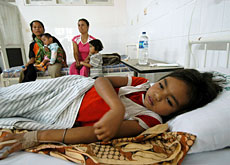Roche questions flu pandemic readiness

Swiss pharmaceutical firm Roche has criticised the world's governments for failing to stockpile enough of its antiviral drug Tamiflu to fight an influenza pandemic.
The World Health Organisation (WHO) has not set specific targets for how much Tamiflu should be in circulation but said it was happy with the preparations of member countries.
The Geneva-based WHO reiterated its warning that an outbreak of a new form of influenza – possibly from a mutation of the bird flu virus – affecting humans was “overdue” and confirmed that Tamiflu was one crucial part of its plans to meet the threat.
Roche head of pharmaceuticals, William Burns, told a conference in Basel on Thursday that government orders for the drug had tailed off in the first quarter of this year despite the company boosting production capacity.
“We have seen in the last two years that most world governments have moved a long way from where they started. But we believe there is still a long way to go…in terms of meeting treatment preparedness…that could dramatically reduce death rates,” he said.
“Capacity constraint is no longer the issue, the issue is demand and how prepared do governments want to be. We can’t just keep building inventory with nobody as a customer.”
Roche has the capacity to produce 400 million treatments a year but will cut production in line with a reducing demand that currently stands at 215 million courses ordered by governments.
WHO content with response
“Out of a population of six billion on the planet that is rather modest,” Burns added.
Roche increased its capacity at the end of last year after coming under international pressure. It has also granted licenses to companies in China, India and South Africa to produce the drug locally.
The WHO, which has a stockpile of three million treatment courses or 30 million capsules, believes a new influenza pandemic is inevitable.
It has estimated that up to a billion people could become infected and that between two and 7.4 million people could die as a result.
Experts say a pandemic could result from a mutation of the H5N1 bird flu strain that spreads from person to person or from another form of the flu virus.
Spokesman Gregory Hartl told swissinfo that more than 170 of the WHO’s 193 member states had some sort of plan to cope with an influenza pandemic.
“That’s a really big indication of the seriousness with which the world is taking the possibility of a new influenza pandemic,” he said.
Countries must decide
But Hartl added that it was up to individual countries to decide how to prepare.
“We can’t make a blanket recommendation for every one of our member states because they have different considerations in terms of the money they have available or other public health priorities. We can’t tell individual governments what to do,” he said.
The stockpiling of antivirals like Tamiflu is only one of a range of options that WHO recommends for a pandemic defence.
The organisation announced at a conference in Geneva on Thursday that it was turning its attention to improving the production and distribution of vaccines. Switzerland has plans to vaccinate the entire population of the country in the event of a flu outbreak.
swissinfo, Matthew Allen
Roche production of Tamiflu:
1999-2002: 5.5 million treatments
2003: 18 million
2004: 27 million
2005: 55 million
2006: 190 million (with the capacity to produce 400 million treatments)
Tamiflu is based on shikimic acid, which can be derived by fermentation or from the pod of the star anise fruit.
It was invented by Gilead Sciences, California, and licensed to Roche in 1996. Tamiflu is patent protected until 2016.
Known generically as oseltamivir, the drug is seen as the best defence against a human pandemic that could be triggered by bird flu, which has been found in wild birds across Asia and Europe.
The H5N1 virus was first isolated and identified in the Guangdong province of China in 1996.
The first cases on human infection were reported in Hong Kong a year later in which 18 people contracted the virus resulting in six deaths.
The latest WHO statistics record 291 confirmed human cases of avian influenza infection with 172 deaths (at April 11, 2007).
A pandemic influenza would be a different mutated strain of the H5N1 avian influenza virus, as yet not in existence, that could spread from human to human.

In compliance with the JTI standards
More: SWI swissinfo.ch certified by the Journalism Trust Initiative












You can find an overview of ongoing debates with our journalists here . Please join us!
If you want to start a conversation about a topic raised in this article or want to report factual errors, email us at english@swissinfo.ch.